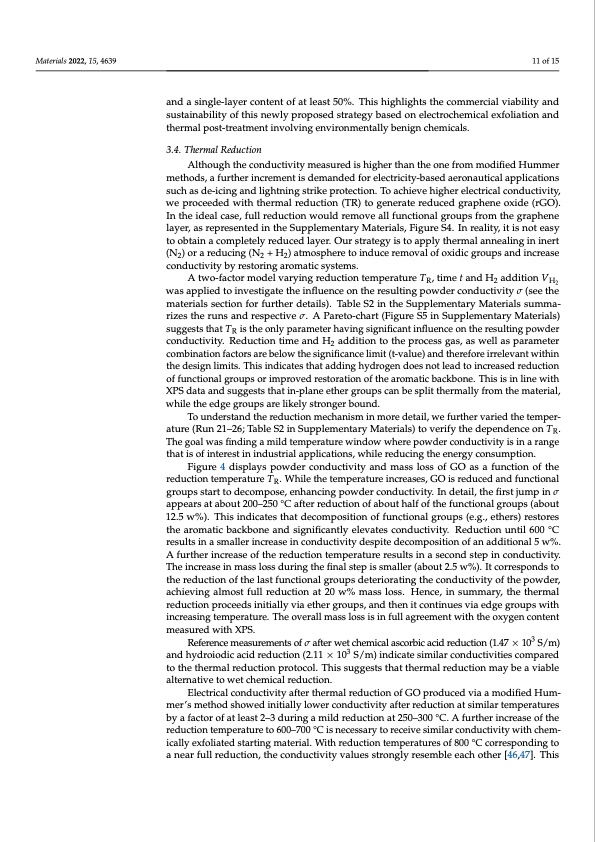
PDF Publication Title:
Text from PDF Page: 011
Materials 2022, 15, 4639 11 of 15 and a single-layer content of at least 50%. This highlights the commercial viability and sustainability of this newly proposed strategy based on electrochemical exfoliation and thermal post-treatment involving environmentally benign chemicals. 3.4. Thermal Reduction Although the conductivity measured is higher than the one from modified Hummer methods, a further increment is demanded for electricity-based aeronautical applications such as de-icing and lightning strike protection. To achieve higher electrical conductivity, we proceeded with thermal reduction (TR) to generate reduced graphene oxide (rGO). In the ideal case, full reduction would remove all functional groups from the graphene layer, as represented in the Supplementary Materials, Figure S4. In reality, it is not easy to obtain a completely reduced layer. Our strategy is to apply thermal annealing in inert (N2) or a reducing (N2 + H2) atmosphere to induce removal of oxidic groups and increase conductivity by restoring aromatic systems. A two-factor model varying reduction temperature TR, time t and H2 addition VH2 was applied to investigate the influence on the resulting powder conductivity σ (see the materials section for further details). Table S2 in the Supplementary Materials summa- rizes the runs and respective σ. A Pareto-chart (Figure S5 in Supplementary Materials) suggests that TR is the only parameter having significant influence on the resulting powder conductivity. Reduction time and H2 addition to the process gas, as well as parameter combination factors are below the significance limit (t-value) and therefore irrelevant within the design limits. This indicates that adding hydrogen does not lead to increased reduction of functional groups or improved restoration of the aromatic backbone. This is in line with XPS data and suggests that in-plane ether groups can be split thermally from the material, while the edge groups are likely stronger bound. To understand the reduction mechanism in more detail, we further varied the temper- ature (Run 21–26; Table S2 in Supplementary Materials) to verify the dependence on TR. The goal was finding a mild temperature window where powder conductivity is in a range that is of interest in industrial applications, while reducing the energy consumption. Figure 4 displays powder conductivity and mass loss of GO as a function of the reduction temperature TR. While the temperature increases, GO is reduced and functional groups start to decompose, enhancing powder conductivity. In detail, the first jump in σ appears at about 200–250 °C after reduction of about half of the functional groups (about 12.5 w%). This indicates that decomposition of functional groups (e.g., ethers) restores the aromatic backbone and significantly elevates conductivity. Reduction until 600 °C results in a smaller increase in conductivity despite decomposition of an additional 5 w%. A further increase of the reduction temperature results in a second step in conductivity. The increase in mass loss during the final step is smaller (about 2.5 w%). It corresponds to the reduction of the last functional groups deteriorating the conductivity of the powder, achieving almost full reduction at 20 w% mass loss. Hence, in summary, the thermal reduction proceeds initially via ether groups, and then it continues via edge groups with increasing temperature. The overall mass loss is in full agreement with the oxygen content measured with XPS. Reference measurements of σ after wet chemical ascorbic acid reduction (1.47 × 103 S/m) and hydroiodic acid reduction (2.11 × 103 S/m) indicate similar conductivities compared to the thermal reduction protocol. This suggests that thermal reduction may be a viable alternative to wet chemical reduction. Electrical conductivity after thermal reduction of GO produced via a modified Hum- mer’s method showed initially lower conductivity after reduction at similar temperatures by a factor of at least 2–3 during a mild reduction at 250–300 °C. A further increase of the reduction temperature to 600–700 °C is necessary to receive similar conductivity with chem- ically exfoliated starting material. With reduction temperatures of 800 °C corresponding to a near full reduction, the conductivity values strongly resemble each other [46,47]. ThisPDF Image | Electrochemical Production Thermal Reduction Graphene Oxide

PDF Search Title:
Electrochemical Production Thermal Reduction Graphene OxideOriginal File Name Searched:
materials-15-04639.pdfDIY PDF Search: Google It | Yahoo | Bing
Salgenx Redox Flow Battery Technology: Power up your energy storage game with Salgenx Salt Water Battery. With its advanced technology, the flow battery provides reliable, scalable, and sustainable energy storage for utility-scale projects. Upgrade to a Salgenx flow battery today and take control of your energy future.
| CONTACT TEL: 608-238-6001 Email: greg@infinityturbine.com | RSS | AMP |